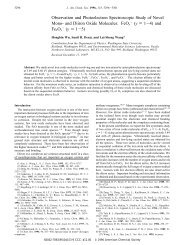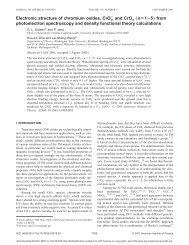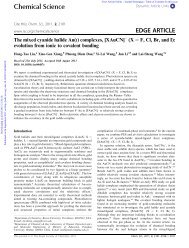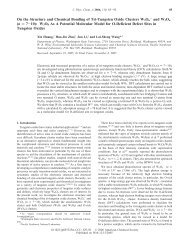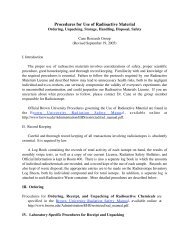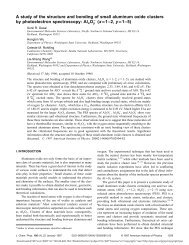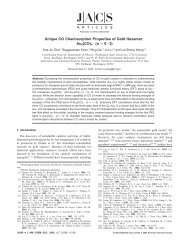C60Ox - American Chemical Society Publications
C60Ox - American Chemical Society Publications
C60Ox - American Chemical Society Publications
Create successful ePaper yourself
Turn your PDF publications into a flip-book with our unique Google optimized e-Paper software.
11089<br />
2005, 109, 11089-11092<br />
Published on Web 11/15/2005<br />
Photoelectron Spectroscopy and Electronic Structures of Fullerene Oxides: C 60 O x<br />
-<br />
(x ) 1-3)<br />
Xue-Bin Wang, Hin-Koon Woo, Boggavarapu Kiran, and Lai-Sheng Wang*<br />
Department of Physics, Washington State UniVersity, 2710 UniVersity DriVe, Richland, Washington 99354, and<br />
W. R. Wiley EnVironmental Molecular Sciences Laboratory and <strong>Chemical</strong> Sciences DiVision, Pacific Northwest<br />
National Laboratory, MS 8-88, P.O. Box 999, Richland, Washington 99352<br />
ReceiVed: October 10, 2005; In Final Form: NoVember 1, 2005<br />
We report a photoelectron spectroscopy (PES) study on a series of fullerene oxides, C 60 O x- (x ) 1-3). The<br />
PES spectra reveal one isomer for C 60 O - , two isomers for C 60 O 2- , and multiple isomers for C 60 O 3- . Compared<br />
to C 60 , the electronic structures of C 60 O x are only slightly perturbed, resulting in similar anion photoelectron<br />
spectra. The electron affinity of C 60 O x was observed to increase only marginally with the number of oxygen<br />
atoms, x, from 2.683 eV for C 60 , to 2.745 eV for C 60 O, and 2.785 eV/2.820 eV for C 60 O 2 (two isomers). We<br />
also carried out theoretical calculations, which confirmed the observed isomers and showed that all the fullerene<br />
oxides are in the form of epoxide. The PES and theoretical calculations, as well as molecular orbital analysis,<br />
indicate that addition of oxygen atoms to the C 60 cage only modifies the local carbon network and leave the<br />
rest of the fullerene cage largely intact geometrically and electronically.<br />
Introduction<br />
Fullerene oxides (C 60 O x ), common residues in fullerene bulk<br />
synthesis as a result of oxidation, are a class of important<br />
functionalized fullerene derivatives. First detected in mass<br />
spectrometry and electrochemical oxidation of C 60 , 1,2 the oxides<br />
were reported to be the starting materials to form large oddnumbered<br />
carbon clusters, such as C 119 . 3-5 Theoretical calculations<br />
suggested that for the fullerene monoxide (C 60 O) there<br />
were two isomers, i.e., [6,6]-closed epoxide (1) and [5,6]-open<br />
oxidoannulene (an ether structure) with comparable stabilities, 6-11<br />
but only the epoxide was initially synthesized 12-14 with the latter<br />
missing until more recently. 15 Oxidation of C 60 with m-<br />
choroperoxybenzoic acid produced bulk quantities of C 60 O 2 and<br />
X-ray diffraction showed it was a fullerene diepoxide with both<br />
oxygen atoms positioned over [6,6] ring junctions on a common<br />
six-member face of the carbon cage (2). 16 HPLC chromatogram<br />
analyses of the reaction products of C 60 with O 3 indicated two<br />
isomers for C 60 O 2 , one with the proposed structure of 2 and<br />
the other one similar to that for 2, but with the two oxygen<br />
atoms bridging the neighboring six-member ring (3). 17 The<br />
electronic structures and electron affinities (EAs) of C 60 O x are<br />
expected to play an important role in any of its applications,<br />
and extensive electrochemical studies have been pursued as<br />
such. 1,18-20 Unlike C 60 and C 60- , which have been intensively<br />
investigated using gas phase photoelectron spectroscopy (PES)<br />
since the early stage of its discovery 21-24 and recently revisited<br />
with vibrational resolution, 25-27 no gas-phase PES study is<br />
available for C 60 O x and their anions.<br />
In this Letter, we report the first PES study of C 60 O - x in the<br />
gas phase. The PES spectra were taken at 70 K with three<br />
different photon energies using a recently constructed lowtemperature<br />
electrospray PES apparatus. Our PES spectra show<br />
* Corresponding author. E-mail: ls.wang@pnl.gov.<br />
10.1021/jp055775e CCC: $30.25<br />
that all oxides have electronic structures similar to that for C 60 ,<br />
with only a slight increase of EA as the number of oxygen atoms<br />
increases. We observe one isomer for C 60 O, two isomers for<br />
C 60 O 2 , and multiple isomers for C 60 O 3 . Theoretical calculations<br />
were carried out to provide further insight into the electronic<br />
and structural properties of the fullerene oxides.<br />
Experimental Details<br />
The experiments were carried out using a newly developed<br />
low-temperature PES apparatus, which consists of an electrospray<br />
ionization source (ESI), a cryogenically cooled ion trap<br />
time-of-flight mass spectrometry, and a magnetic bottle timeof-flight<br />
photoelectron analyzer. 27 The ESI source and the<br />
magnetic-bottle photoelectron spectrometer are similar to that<br />
described previously. 28 C 60 O - x anions were produced as byproducts<br />
from a solution intended to generate C 60- anions in an<br />
acetonitrile solution. 29 After guided by a RF-only octopole and<br />
a quadrupole mass filter (operated in the RF-only mode), all<br />
anions were turned 90° via a quadruple ion bender and entered<br />
into a three-dimensional Paul trap for ion accumulation and<br />
collision cooling. The ion trap was attached to a cold head of<br />
a cryostat and its temperature can be controlled from 10 to 400<br />
K. For the current experiment, the trap was kept at 70 K and<br />
the collision background gas used was 10 -4 Torr N 2 . The cooled<br />
ions were pulsed out of the trap at a 10 Hz repetition rate and<br />
separated in a linear TOF mass spectrometer according to their<br />
respective mass-to-charge ratios. The C 60 O - x (x ) 0-3) anions<br />
of interest were selected by a pulsed mass-gate, and decelerated<br />
before being intercepted by a detachment laser beam in the<br />
interaction zone of the magnetic-bottle electron analyzer. In the<br />
current experiment, three detachment photon energies were<br />
used: 355 nm (3.496 eV) and 266 nm (4.661 eV) from a Nd:<br />
YAG laser, and 193 nm (6.424 eV) from an excimer laser. The<br />
detachment laser was operated at 20 Hz with the ion beam off<br />
© 2005 <strong>American</strong> <strong>Chemical</strong> <strong>Society</strong>
11090 J. Phys. Chem. A, Vol. 109, No. 49, 2005 Letters<br />
Figure 1. Photoelectron spectra of C 60O x- (x ) 1-3) at 266 nm (4.661<br />
eV) and 193 nm (6.424 eV), compared with that of C 60- from ref 27.<br />
on alternate shots for background subtraction. The photodetached<br />
electrons were collected with nearly 100% efficiency<br />
by the magnetic-bottle and analyzed in a 5.2 m long electron<br />
flight tube. The electron energy resolution of the apparatus is<br />
∆E/E ∼2%, i.e., 20 meV for 1 eV electrons. Photoelectron timeof-flight<br />
spectra were collected and then converted to kinetic<br />
energy spectra, calibrated by the known spectra of I - and<br />
ClO 2 - . 30 The electron binding energy spectra presented here<br />
were obtained by subtracting the kinetic energy spectra from<br />
the detachment photon energies.<br />
Theoretical Methods<br />
All calculations were done at the level of generalized gradient<br />
approach using the Perdew-Wang exchange-correlation functional.<br />
31 The standard Slater-type-orbital (STO) basis set with<br />
quality of triple-ζ plus with two sets of polarization functions<br />
(TZ2P) were used for the valence orbitals of all the atoms, with<br />
frozen core approximation. The geometries of all molecules<br />
(both anions and neutrals) were fully optimized with default<br />
convergence criteria. The adiabatic detachment energies (ADEs)<br />
were obtained by taking the energy difference between the<br />
anions and the neutrals in their optimized geometries. All the<br />
calculations were accomplished using the Amsterdam density<br />
functional (ADF 2004.01) program. 32<br />
Experimental Results<br />
Figure 1 shows the PES spectra of C 60 O - x (x ) 1-3) at 266<br />
nm (left) and 193 nm (right). The low-temperature spectra of<br />
C - 60 , which have been recently reported, 27 are shown for<br />
comparison. Major spectral features are labeled X, A, B, and C<br />
in the order of increasing electron binding energies. Surprisingly,<br />
the spectra of the C 60 O - x oxides are very similar to that of C - 60 .<br />
In particular, the spectra of C 60 O - are almost identical to those<br />
of C 60- with only a slight increase of electron binding energies.<br />
The HOMO-LUMO gap of C 60 O, defined by the X-A<br />
separation, is 1.52 eV, which is only slightly lower than that of<br />
C 60 (1.62 eV). 27 The quality of the spectra for C 60 O - 2 and<br />
C 60 O - 3 was poorer due to their weak mass intensities, but their<br />
similarity to the C - 60 spectra is obvious. Even the autodetachment<br />
features, labeled “AD” in the 266 nm spectrum of C - 60 ,<br />
are also present in the oxide spectra as weak signals in the<br />
HOMO-LUMO band gap region. Vibrational structures were<br />
also discernible in the X band of the oxide spectra at both 193<br />
and 266 nm, and they also appeared to be similar to that of the<br />
C 60- spectra. The HOMO-LUMO gaps of C 60 O 2 and C 60 O 3<br />
are estimated to be 1.5 eV, similar to that of C 60 O. Due to<br />
existence of multiple isomers for the higher oxides (as discussed<br />
below) and poorer resolution, the 1.5 eV HOMO-LUMO gap<br />
should be regarded as the average of the different isomers. The<br />
HOMO-LUMO gaps for all species are summarized in Table<br />
1.<br />
The details of the vibrational structures in the first PES band<br />
of C 60 O - x , were revealed more clearly at 355 nm (Figure 2).<br />
Vibrational structures of C 60 O - are seen to be identical to that<br />
of C - 60 , even though the resolution of the C 60 O - spectrum was<br />
slightly poorer. This observation suggests that the vibrational<br />
modes and their frequencies excited in the ground-state transition<br />
in C 60 O - and C 60- are identical; i.e., the O atom has very little<br />
perturbation to the electronic and geometrical structures of the<br />
C 60 cage in C 60 O, indicating the electronic and structural<br />
robustness of the C 60 cage structure. The EA of C 60 O is<br />
measured accordingly from the 0-0 transition to be 2.745 eV,<br />
compared to 2.683 eV for C 60 in Table 1.<br />
The vibrational structures in the 355 nm spectrum of C 60 O<br />
- 2<br />
were poorly resolved. However, two peaks (X 1 and X 2 ) were<br />
resolved for what appeared to be the 0-0 transition. These two<br />
peaks could be due to a vibrational progression of a low<br />
frequency mode. But they are most likely due to the 0-0<br />
transitions for two isomers of C 60 O - 2 , as verified below by the<br />
theoretical calculations. From the peak positions of X 1 and X 2 ,<br />
we obtained the ADEs for these two isomers of C 60 O 2- as 2.785<br />
eV (X 2 ) and 2.820 eV (X 1 ). The 355 nm spectrum of C 60 O<br />
- 3<br />
was even less resolved, partly due to the poorer resolution and<br />
partly due to the fact that multiple isomers were expected to be<br />
present for C 60 O 3- . Thus, we could not obtain the ADE for<br />
C 60 O - 3 . An estimate of 2.8 eV is listed in Table 1, which should<br />
be viewed as an average of the different isomers.<br />
Theoretical Results<br />
We carried out theoretical calculations using density functional<br />
theory with the TZ2P basis set. For C 60 O - , the lowest<br />
TABLE 1: Experimental and Theoretical Adiabatic Detachment Energies (ADEs) of C 60- and C 60 O x- (x ) 1-3) and the<br />
Measured HOMO-LUMO Gaps for the Neutral Species (All Energies in eV)<br />
C<br />
- 60 C 60O - (isomer 1)<br />
C 60O<br />
- 2<br />
C 60O 2<br />
-<br />
(isomer 2) C 60O 3<br />
-<br />
ADE (expt) a,b 2.683(8) 2.745(8) 2.820(10) 2.785(10) ∼2.8<br />
ADE (cal) 2.86 2.95 3.02 3.00<br />
HOMO-LUMO gap 1.62 ( 0.01 c 1.52 ( 0.01 ∼1.5 ∼1.5 ∼1.5<br />
a<br />
The ADEs were determined from the 0-0 transitions in the 355 nm spectra (Figure 2) except for C 60O 3- , for which only a rough estimate from<br />
the detachment threshold was obtained. The ADEs also represent the EA of the corresponding neutral species. b Numbers in parentheses are uncertainties<br />
in the last digits. c From ref 27.
Letters J. Phys. Chem. A, Vol. 109, No. 49, 2005 11091<br />
Figure 4. First three highest occupied molecular orbitals of C 60O -<br />
(1) and C 60O 2- (2, 3).<br />
Figure 2. Photoelectron spectra of C 60O x- (x ) 1-3) at 355 nm (3.496<br />
eV), compared with that of C 60- from ref 27 with assignments of the<br />
main vibrational features.<br />
Figure 3. Optimized structures of C 60O - (1) and C 60O 2- (2, 3). The<br />
numbers are the relative energies in electronvolts for the anions and<br />
the neutrals (in parentheses).<br />
energy structure is the epoxide structure with the oxygen<br />
bridging one [6,6] C-C bond (1) (Figure 3). We identified two<br />
low-lying diepoxide isomers for C 60 O 2- separated by only 0.33<br />
eV in energy. For the more stable isomer 1 (2), the two oxygen<br />
atoms position over [6,6] ring junctions on one six-member ring,<br />
whereas for isomer 2 (3) they bridge the [6,6] C-C bond over<br />
neighboring six-member rings (Figure 3). The energetics of<br />
C 60 O 2 neutrals are similar to that of the anions, and isomer 2 is<br />
0.31 eV higher in energy. The calculated ADEs for C 60 O - and<br />
C 60 O 2 - are compared with the experimental values in Table 1.<br />
The calculated values are ∼0.2 eV higher than the experimental<br />
ones but reproduce the experimental trend well. Particularly,<br />
the calculation predicts that the more stable isomer 1 of C 60 O 2<br />
-<br />
has a slightly higher ADE compared to that of isomer 2,<br />
consistent with the experimental observation (Figure 2).<br />
Discussions<br />
The PES spectra of C - 60 have been reported before and are<br />
well understood. 25-27 The HOMO of C 60 is a 5-fold degenerate<br />
h u orbital. In C 60- , the extra electron enters the LUMO of C 60 ,<br />
t 1u , which is subject to Jahn-Teller distortion, giving rise to a<br />
complicated vibrational structure for the transition from the<br />
ground state of C - 60 ( 2 T 1u ) to the ground state of C 60 neutral<br />
( 1 A g ) because of the vibronic coupling with the two A g and<br />
eight H g modes. This has been discussed in detail before 25-27<br />
and several assignments are reproduced in Figure 2 for C - 60 .<br />
The apparent similarity between the C 60 O - x and C - 60 spectra<br />
indicates the oxides have electronic and geometrical structures<br />
essentially similar to that of C 60 although the overall symmetries<br />
are lower for the oxides. This is born out from the calculations.<br />
As shown in Figure 3, each oxygen atom breaks one CdC<br />
double bond to form two epoxide bonds locally and does not<br />
seem to induce global changes to the cage. The valence MOs<br />
of the oxides are still expected to be composed of the p orbitals<br />
from the cage (C-C π orbital), very much like the bare C 60 .<br />
These are shown clearly in Figure 4. We note that the O atoms
11092 J. Phys. Chem. A, Vol. 109, No. 49, 2005 Letters<br />
have very little contribution to the valence MOs of the oxides<br />
and they only affect the proximal carbons. Thus the C 60 O x oxides<br />
can be viewed as O atoms chemisorbed to the C 60 surface.<br />
According to geometrical structure analyses, there can be two<br />
isomers for the fullerene monoxide C 60 O ([5,6]-open oxidoannulene<br />
and [6,6]-closed epoxide) and eight isomers for the<br />
fullerene dioxide C 60 O 2 . 10 Although the two isomers of C 60 O<br />
are predicted to have similar stabilities with a high conversion<br />
barrier between them, experimentally only the epoxide was<br />
found initially. 12-14 The [5,6]-open isomer has been discovered<br />
more recently with photolysis of a C 60 ozonation solution. 15 We<br />
believe the monoxide observed in our experiment is the [6,6]-<br />
closed epoxide because it was produced via slow thermal<br />
reaction of C 60 with O 2 , as reported similarly in the literature. 1,12-14<br />
For C 60 O 2 , we observed two dominant isomers (2, 3) among<br />
eight possible ones, also consistent with the previous studies. 16,17<br />
The broadness of our PES spectra of C 60 O 3- indicates the<br />
presence of multiple isomers. This observation agrees with two<br />
previous reports showing three isomers existed for the trioxides<br />
in the product mixtures of oxidation of fullerenes by ozone. 33,34<br />
In conclusion, we report a combined PES and theoretical<br />
study on a series of fullerene oxides, C 60 O x (x ) 1-3). Our<br />
spectra reveal similar electronic structures for the oxides<br />
compared to that of C 60 . This similarity is confirmed via MO<br />
analyses. The EAs of C 60 O x are found to increase slightly with<br />
the oxygen content, x. We observed one isomer for C 60 O - , two<br />
dominant isomers for C 60 O 2 - , and multiple isomers for C 60 O 3 - .<br />
Our results showed that O atoms only perturb the C 60 cage<br />
locally and have very little global effect on the C 60 cage. This<br />
finding demonstrates the electronic and structural stability of<br />
the C 60 cage.<br />
Acknowledgment. This work was supported by the National<br />
Science Foundation (CHE-0349426), and was performed at the<br />
W. R. Wiley Environmental Molecular Sciences Laboratory, a<br />
national scientific user facility sponsored by DOE’s Office of<br />
Biological and Environmental Research and located at Pacific<br />
Northwest National Laboratory, which is operated for DOE by<br />
Battelle. All calculations were performed with supercomputers<br />
at the EMSL Molecular Science Computing Facility.<br />
References and Notes<br />
(1) Kalsbeck, W. A.; Thorp, H. H. J. Electroanal. Chem. 1991, 314,<br />
363.<br />
(2) Wood, J. M.; Kahr, B.; Hoke, S. H., II; Dejarme, L.; Cooks, R. G.;<br />
Ben-Amotz, D. J. Am. Chem. Soc. 1991, 113, 5907.<br />
(3) McElvany, S. W.; Callahan, J. H.; Ross, M. M.; Lamb, L. D.;<br />
Huffman, D. R. Science 1993, 260, 1632.<br />
(4) Deng, J.-P.; Ju, D.-D.; Her, G.-R.; Mou, C.-Y.; Chen, C.-J.; Lin,<br />
Y.-Y.; Han, C.-C. J. Phys. Chem. 1993, 97, 11575.<br />
(5) Beck, R. D.; Brauchle, G.; Stoermer, C.; Kappes, M. J. Chem. Phys.<br />
1995, 102, 540.<br />
(6) Raghavachari, K. Chem. Phys. Lett. 1992, 195, 221.<br />
(7) Raghavachari, K.; Sosa, C. Chem. Phys. Lett. 1993, 209, 223.<br />
(8) Menon, M.; Subbaswamy, K. R. Chem. Phys. Lett. 1993, 201, 321.<br />
(9) Wang, B.-C.; Chen, L.; Chou, Y.-M. J. Mol. Struct. 1998, 422,<br />
153.<br />
(10) Wang, B.-C.; Chen, L.; Lee K.-J.; Cheng, C.-Y. J. Mol. Struct.<br />
1999, 469, 127.<br />
(11) Manoharan, M. J. Org. Chem. 2000, 65, 1093.<br />
(12) Creegan, K. M.; Robbins, J. L.; Robins, W. K.; Millar, J. M.;<br />
Sherwood, R. D.; Tindall, P. J.; Cox, D. M. J. Am. Chem. Soc. 1992, 114,<br />
1103.<br />
(13) Elemes, Y.; Silverman, S. K.; Sheu, C.; Kao, M.; Foote, C. S.;<br />
Alvarez, M. M.; Whetten, R. L. Angew. Chem., Int. Ed. Engl. 1992, 31,<br />
351.<br />
(14) Balch, A. L.; Costa, D. A.; Lee, J. W.; Noll, B. C.; Olmstead, M.<br />
M. Inorg. Chem. 1994, 33, 2071.<br />
(15) Weisman, R. B.; Heymann, D.; Bachino, S. M. J. Am. Chem. Soc.<br />
2001, 123, 9720. Tsyboulski, D.; Heymann D.; Bachino, S. M.; Alemany<br />
L. B.; Weisman, R. B. J. Am. Chem. Soc. 2004, 126, 7350.<br />
(16) Balch, A. L.; Costa, D. A.; Noll, B. C.; Olmstead, M. M. J. Am.<br />
Chem. Soc. 1995, 117, 8926.<br />
(17) Deng, J.-P.; Mou, C.-Y.; Han, C.-C. J. Phys. Chem. 1995, 99,<br />
14907.<br />
(18) Fedurco, M.; Costa, D. A.; Balch, A. L.; Fawcett, W. R. Angew.<br />
Chem., Int. Ed. Engl. 1995, 34, 194.<br />
(19) Winkler, K.; Costa, D. A.; Balch, A. L.; Fawcett, W. R. J. Phys.<br />
Chem. 1995, 99, 17431.<br />
(20) Echegoyen, L.; Echegoyen, L. E. Acc. Chem. Res. 1998, 31, 593.<br />
(21) Yang, S. H.; Pettiette, C. L.; Conceicao, J.; Cheshnovsky, O.;<br />
Smalley, R. E. Chem. Phys. Lett. 1987, 139, 233.<br />
(22) Wang, L. S.; Conceicao, J.; Jin, C.; Smalley, R. E. Chem. Phys.<br />
Lett. 1991, 182, 5.<br />
(23) Wang, L. S.; Alford, J. M.; Chai, Y.; Diener, M.; Zhang, J.;<br />
McClure, S. M.; Guo, T.; Scuseria, G. E.; Smalley, R. E. Chem. Phys. Lett.<br />
1993, 207, 354.<br />
(24) Brink, C.; Anderson, L. H.; Hvelplund, P.; Mathur, D.; Voldstad,<br />
J. D. Chem. Phys. Lett. 1995, 233, 52.<br />
(25) Gunnarsson, O.; Handschuh, H.; Bechthold, P. S.; Kessler, B.;<br />
Ganteför, G.; W. Eberhardt, W. Phys. ReV. Lett. 1995, 74, 1875.<br />
(26) Wang, X. B.; Ding, C. F.; Wang, L. S. J. Chem. Phys. 1999, 110,<br />
8217.<br />
(27) Wang, X. B.; Woo, H. K.; Wang, L. S. J. Chem. Phys. 2005, 123,<br />
051106-1-4.<br />
(28) Wang, L. S.; Ding, C. F.; Wang, X. B.; Barlow, S. E. ReV. Sci.<br />
Instrum. 1999, 70, 1957.<br />
(29) Subramanian, R.; Boulas, P.; Vijayashree, M. N.; D’Souza, F.;<br />
Jones, M. T.; Kadish, K. M. J. Chem. Soc. Chem. Commun. 1994, 1847.<br />
(30) Gilles, M. K.; Polak, M. L.; Lineberger, W. C. J. Chem. Phys. 1992,<br />
96, 8012.<br />
(31) (a) Perdew, J. P.; Wang, Y. Phys. ReV. B1992, 45, 13244, (b)<br />
Perdew, J. P.; Chevary, J. A.; Vosko, S. H.; Jackson, K. A.; Perderson, M.<br />
R.; Singh, D. J.; Foilhais, C. Phys. ReV. B1992, 46, 6671.<br />
(32) ADF. 2004.01 SCM, Theoretical Chemistry, Vrije Universiteit,<br />
Amsterdam, The Netherlands.<br />
(33) Deng, J. P.; Mou, C. Y.; Han, C. C. Fullerene Sci. Technol. 1997,<br />
5, 1033.<br />
(34) Deng, J. P.; Mou, C. Y.; Han, C. C. Fullerene Sci. Technol. 1997,<br />
5, 1325.



